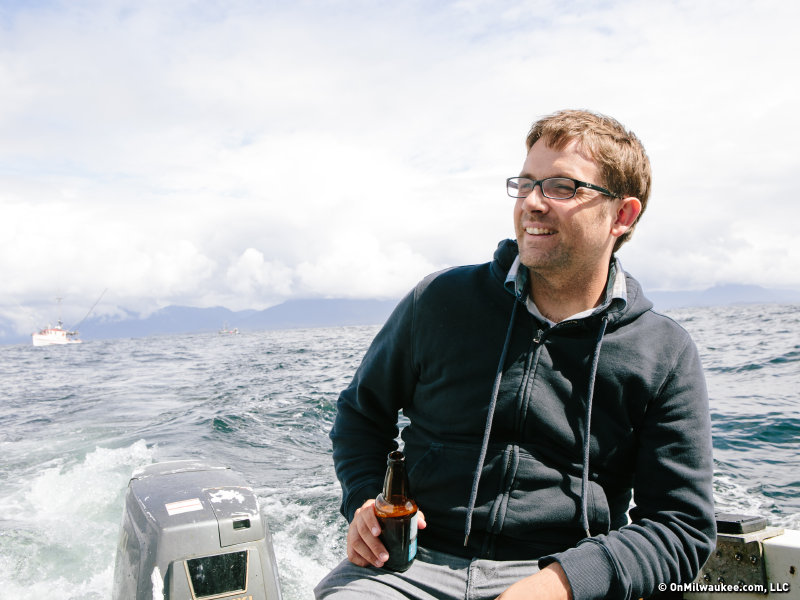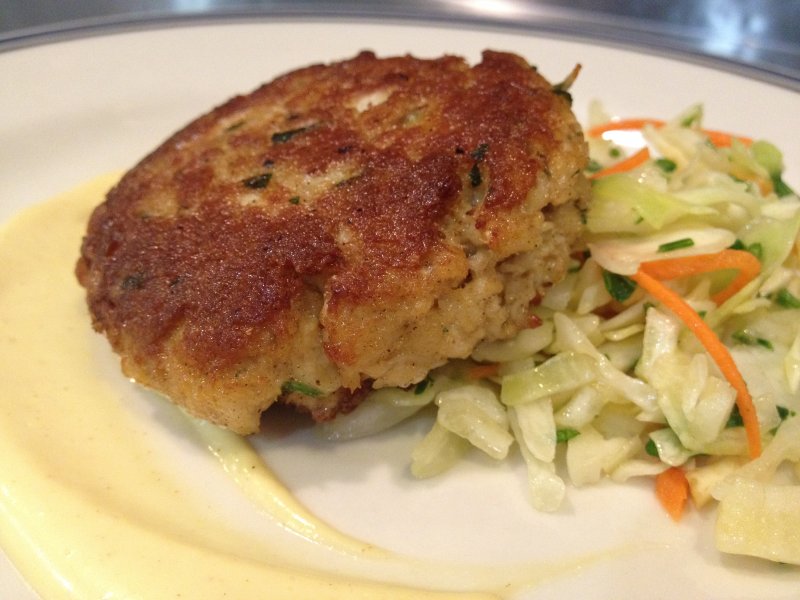For the eighth straight year, October is Dining Month on OnMilwaukee.com, presented by Locavore, the newest restaurant at Potawatomi Hotel & Casino. All month, we're stuffed with restaurant reviews, delectable features, chef profiles and unique articles on everything food, as well as the winners of our "Best of Dining 2014."
You’ve probably been there. You’re sitting down in a restaurant – potentially even a reputable one – and you decide you’re in the mood for seafood. You look over the menu and order the mouthwatering salmon entree.
When the dish arrives, it’s beautifully plated. The sides are well-appointed, and it looks almost too good to eat. But, the salmon? Maybe it smells or tastes slightly fishy. It could be that the flavor is dull or the texture a bit soft, or even mushy. Edible? Maybe. Memorable? Probably not for the right reasons.
Let’s be honest, the Midwest doesn’t exactly have a reputation for serving world-class seafood. And part of that has everything to do with timing.
Alaskan salmon travels over 2,000 miles to get to the Milwaukee market. On average, it might leave Alaska a few days after being caught, at which point it’s generally shipped to Chicago, and then trucked up to Milwaukee from there. It’s at least five days before a fish like salmon enters the marketplace, and that’s even with modern air freight and overnight flights.
When you consider that salmon has a shelf-life of about eight days, that doesn’t bode well for freshness.
But, companies like Sitka Salmon Shares are working to change that. Sitka runs a Community Supported Fisheries program, which delivers fresh seafood to individuals in markets like Milwaukee, Madison, Chicago, Indianapolis, Peoria and the Twin Cities.
Sitka works with eight small-boat fishermen, like Sara Ohlin, Martin and Jev Shelton, and Marsh Skeele, who man fishing vessels with names like "Loon," "Sunfish" and "Tiburon." Their salmon is processed and packed on ice within an hour of being caught. And it’s brought to shore within three days– about half the time normally seen in the industry. Once it arrives, it’s flash frozen and distributed to the Midwestern market, making it some of the freshest seafood available.
In fact, as crazy as it might sound, a frozen fillet of Sitka salmon caught in July and eaten in February will actually taste much better than fresh supermarket salmon.
And Sitka doesn’t just distribute to individuals. Chefs from Milwaukee restaurants including Braise, La Merenda, Amilinda and Blue Jacket also serve Sitka’s salmon, and for good reason.
"When one talks about sustainable agriculture we have to address sustainable aquaculture," says Chef Dave Swanson of Braise. "The adverse effects of intensive commercial fish farming – for example, farm raised salmon – cannot be ignored. Traceability has been an obstacle in the seafood industry. Sitka Salmon Shares gives us the traceability we need to obtain the same standards and relationships we have with our local farmers. We now know who, a.k.a. the farmer, the when, where and how."
Curious to learn more about Sitka, I reached out to Nicolaas Mink, President and Chief Salmon Steward of Sitka Salmon Shares.
Mink is a food author whose writing includes "Salmon: A Global History," which was published in 2012. He’s also a professor, who spends the fall and spring terms as the Urban Sustainable Foods Fellow at Butler University’s Center for Urban Ecology. And he happens to be a nationally-recognized expert on sustainable food systems.
OnMilwaukee.com: How did Sitka Salmon Shares come about? Or, how did you go from environmental food historian to fish entrepreneur?
Nicolaas Mink: I've always been broadly interested in the ecological implications of eating. I spent about 10 years studying the phenomenon as a historian, then shifted gears into advocacy and outreach that sought to raise awareness about the ecological consequences of food production and consumption.
Sitka Salmon Shares came about after I moved to Sitka to do work on wild salmon education for the conservation society there. During that time, I met all of the fishermen who currently fish for us. We started the company to help educate consumers about wild salmon and provide fishermen, who wanted to fish for quality, a better market for their product.
OMC: What makes Sitka different from other options for sourcing seafood?
NM: Well, it begins with the fact that we can tell our consumers everything about every single fish that we sell, from the moment it was caught until the moment it hits their home. We know the boat that it's from, we know where it was caught, how it was caught, and the conditions under which it was caught. Outside of a few Alaskan salmon fishermen who direct market their product in the Midwest, that type of traceability is unmatched for seafood here. Having sound information allows consumers to make good food choices, and we think we provide that.
Another big difference is we sell the vast majority of our fish through a CSA model, meaning our consumers pay up front for a share of the harvest from our fishermen. This allows us to provide stable, secure prices for our fishermen, minimizing risk for them. This is huge in the world of fishing, where prices can be pretty unstable.
We also really try to provide an experience for our members as well. We know people are pretty nervous about cooking fish at home, so we have an in-house chef who tailors recipes for our fish and for members who come from different cooking levels. We also do blog posts, videos, recipes contests – things like that. We're really driven by the idea of community, for our fishermen and our members.
OMC: Sustainability has gotten complicated. What can you say about the prevalence of the term and the actuality of sustainability?
NM: More and more consumers seek "sustainable seafood" because they know about the problems with overfishing. Overall, this is a net positive for the health of the oceans. At the same time, I'd love more consumers to understand that sustainability needs to be thought about in the context of community.
A lot of seafood labeled sustainable or "best choice" is caught by large factory ships that don't do much for fishing communities and certainly don't do much for small scale fishermen.
In fact, the trend in fishing over the last few decades is that our environmental management of the resource has generally improved, but it has come at a high cost for small scale fishermen and the communities they support. Small scale fishermen are being driven out of the game by larger, better capitalized boats that don't fish with the same values and certainly don't keep money in fishing communities in the way that smaller fishermen do.
I wish more consumers were informed about these issues and would understand this more holistic view of sustainability. We're sacrificing healthy communities for a better environment, even though we don't have to.
OMC: You're dealing with a relatively small number of fishermen. What's the advantage of working with them so closely?
NM: Our whole system is built on trust and, even, friendship. We all spend time together socially. We eat dinner at each others' houses almost every day. Most of our fishermen fish cooperatively. All of this adds up to a pretty strong bond that has allowed our company to thrive. I can call any of them at just about any time of the day, and they can do the same with me. This has certainly allowed us to work through problems we've encountered along the way and has allowed us to be resilient. Building this system has not been easy and our personal relationships have gotten us through.
OMC: Are there any particular stories about your fishing crew you can share that tell the story of Sitka?
NM: There are too many great stories!
Our fisheries director, Marsh, was just late for his second spot prawn trip because he couldn't find the perfect wine and cheese for the spot prawn pasta he wanted to make on the boat. To me, that's so representative of us: we're a company that is focused on good food.
OMC: And, speaking of good food, what has it been like developing a relationship with restaurants like Braise?
NM: Chef Dave has been great. He's a huge supporter and gets what we're trying to do. Small fishermen, much like small farmers, really need the support of chefs to survive. Braise and a growing number of Milwaukee chefs have allowed us to do just that.
For more information about Sitka Salmon Shares, including a number of delicious salmon recipes, visit the web site at sitkasalmonshares.com
Or join Braise Restaurant for Supper Club on Tuesday, Oct. 21 as it welcomes Marsh Skeele, captain of the fishing vessel Loon, for a four course dinner featuring wild Alaskan Coho, Sockeye, black cod and spot prawns. The dinner is $80 per person.
Or, if a class is more your style, sign up for the "Sustainable Seafood with Sitka Salmon Shares" class at Braise on Thursday, Oct. 23. Attendees will meet Sitka fisherman, Marsh Steele, who will share the Sitka Salmon Shares story and show guests how to break down a whole king salmon. Chef Dave Swanson will demonstrate how to prepare some delicious seafood dishes. Tickets for the class are $65 per person.
Tickets are available online for both the Supper Club and the salmon class.
As a passionate champion of the local dining scene, Lori has reimagined the restaurant critic's role into that of a trusted dining concierge, guiding food lovers to delightful culinary discoveries and memorable experiences.
Lori is an avid cook whose accrual of condiments and spices is rivaled only by her cookbook collection. Her passion for the culinary industry was birthed while balancing A&W root beer mugs as a teenage carhop, fed by insatiable curiosity and fueled by the people whose stories entwine with every dish. Lori is the author of two books: the "Wisconsin Field to Fork" cookbook and "Milwaukee Food". Her work has garnered journalism awards from entities including the Milwaukee Press Club. In 2024, Lori was honored with a "Top 20 Women in Hospitality to Watch" award by the Wisconsin Restaurant Association.
When she’s not eating, photographing food, writing or planning for TV and radio spots, you’ll find Lori seeking out adventures with her husband Paul, traveling, cooking, reading, learning, snuggling with her cats and looking for ways to make a difference.



.jpeg)



